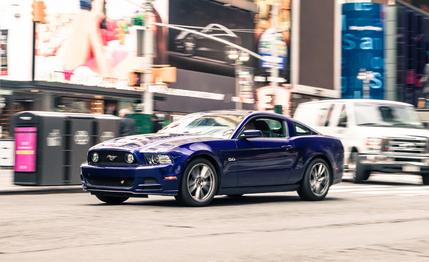 Long-Term Road Test Wrap-Up
Long-Term Road Test Wrap-Up
We’d petitioned Ford for a long-term Mustang ever since the 2010 model made its debut. This fifth-generation Mustang felt like a reborn car, even if its solid axle is to automotive componentry what the polyester leisure suit is to modern menswear. The Mustang fully exploited its mix of new and old tech to win multiple comparison tests, knocking off higher-powered offerings from Dodge and Chevy in the process. Not insignificantly, it also collected three consecutive 10Best trophies (2011–13).

The 2010 model floored us with its athleticism, especially when endowed with the optional Track package. We asked very nicely for a Boss 302 long-term tester, the best-handling model that is now discontinued. Protracted negotiations instead produced this 2013 “Deep Impact Blue” GT with the $2495 Track package, which includes Pirelli P Zero summer tires, upgraded brakes, and a 3.73:1 differential of the limited-slip variety. By the time we’d spec’d our long-term pony, the GT’s 5.0-liter V-8 had gained eight horsepower, making for a total of 420, a number sure to amuse recreational weed enthusiasts.
Optional Recaro seats ($1595) complement the aggressive Track package and have significantly more hindquarter-holding capability than the stock buckets. Showing uncharacteristic restraint, we passed on other pricey add-ons, such as navigation, automatic climate control, and the glass roof, but we did select the $4000 Premium package for its leather seats, satellite radio, and uprated stereo with Sync. Scandalously, the Premium pack and optional Recaro buckets can’t be paired to produce seat heaters, and the power-seat upgrade normally included in the Premium package isn’t included with the Recaros.
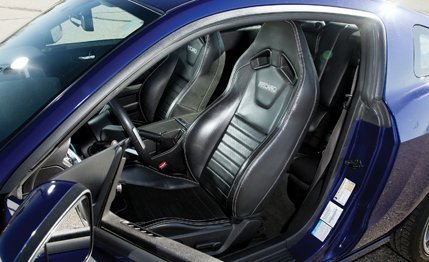 The spectacular and optional Recaro seats are manually adjusted. Oh, how we suffered! And the cup-holder location is terrible.
The spectacular and optional Recaro seats are manually adjusted. Oh, how we suffered! And the cup-holder location is terrible.
Two zero-cost options, stripe-delete and spoiler-delete, kept our blue coupe as incognito as possible, placating deputy editor Daniel Pund because he hates decklid aero accouterment. Except on Hyundais.
At $39,185, our GT was, on paper, as perfect for enthusiasts as the order guide would allow, and early logbook comments confirmed that the GT is a great everyday muscle car. Its power to pin passengers in the seats distracts from any refinement or comfort shortcomings, such as the teeter-totter body motion amplified by some sections of interstate. Speaking of which, the optional Recaros proved more comfortable than the soft-sided stock buckets we’ve experienced in other testers, though many drivers found themselves struggling for the perfect seating position because of a burly clutch pedal and the lack of a telescoping steering wheel.
Yet the Mustang moved even copy chief Carolyn Pavia-Rauchman, no idle waster of exclamation points, to exclaim: “This is wild! And fun!” Our initial testing validated her punctuation. The Stang hit 60 mph in 4.5 seconds and made a 13.0-second quarter-mile pass at 111 mph—the best acceleration we’ve ever recorded in a GT. Shortly after the visit to the track, however, the Mustang developed a rough idle, so off it went to the dealer for what would prove to be the first of four unscheduled service stops. The dealer confirmed that cylinder No. 1 had misfired several times. Unable to re-create the problem, though, the dealer sent us on our way. The misfire never recurred.
The Mustang doesn’t have a strict service schedule. Rather, the engine computer determines when a service is necessary. The owner’s manual says that under normal operation, a message reading “oil change required” should pop up in the instrument cluster between 7500 and 10,000 miles. We didn’t see it until about 10,000 miles.
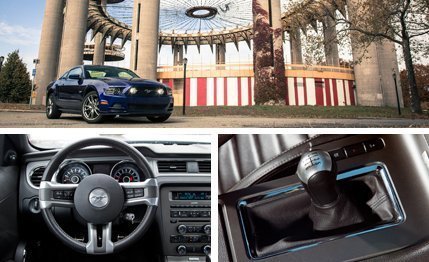
The differential developed a whine just before the car’s first regular service, which calls for an oil change and a tire rotation and cost us $58. The dealer confirmed what we were hearing and ordered new ring and pinion gears. Later, we learned that Ford issued a technical service bulletin on the diff, implying we were not the first to experience the horror-movie soundtrack of misaligned gears. Within a week, the dealer had the fresh parts, and we figured another half-day at the shop was all that was needed to handle the fix. Unfortunately, the dealership botched the installation, resulting in a severe driveline vibration. The dealer ultimately returned the car to us in good working order, but the whole ordeal accounted for two of the Mustang’s four unscheduled stops.
The second service, after another 10,000 miles, came and went without a snag and cost us exactly $5 less. The third service was, however, an eye-opener. While we slept, Ford changed the oil specification for Track-pack GTs from a 5W-20 synthetic blend to a pricier 5W-50 full-synthetic. With an air filter, the service cost nearly tripled, to $146.
A chassis squeak developed before the third service. If we didn’t have to drive over four large “sleeping policemen” to get to C/D’s Galactic Headquarters every morning, the squeaks might have gone unnoticed; perhaps they never would have appeared. The dealer confirmed the noise and ordered new control arms for the front struts, complete with noise-free bushings. It took two months for the parts to arrive.
At the final, 40,000-mile service, the dealer opted to not change the cabin filter because it wasn’t dirty. Four services totaling $362 isn’t too painful, but if we owned the car, we would probably stop paying top dollar for oil changes after the 60,000-mile powertrain warranty expired.
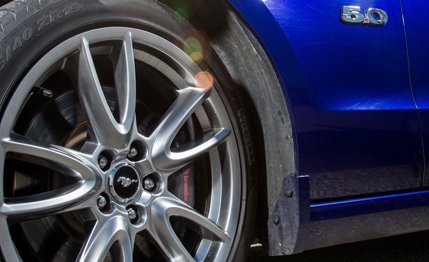 The Brembo front brakes and Pirelli summer tires are part of the $2495 Track pack along with a 3.73:1 differential of the limited-slip variety.
The Brembo front brakes and Pirelli summer tires are part of the $2495 Track pack along with a 3.73:1 differential of the limited-slip variety.
Living with a car for more than a year, we discover things we might not in a one- or two-day drive. For example, the Premium package includes ambient lights, console lights, and cup-holder lights, which can be customized to any one of 125 different colors. This fairly gimmicky feature normally wouldn’t warrant a mention, but even in their dimmest setting, the lights are too bright, reflect off the windshield at night, and, in general, adversely affect night vision.
The cup-holder location, lights or not, couldn’t be less appealing. The two-hole, molded-in holder is located just aft of the shifter beside the parking brake. That’s premium real estate, and with a drink nestled in, there is nowhere for the driver to rest a right arm during long hauls.
After we installed a set of Bridgestone Blizzak LM-60 winter tires for the snowy months ($936 plus installation), executive editor Aaron Robinson noted that “the old biases about rear-drive being death in the snow are just that: biases.” The Blizzaks inspired confidence, even if last winter was mild by Michigan standards.
After winter, we reinstalled the Pirellis that came on the car. They wore out, however, at 25,000 miles, so we fit a new set before exposing the GT to its final batch of tests. Each of these P Zeros costs $326, which might entice Mustang owners to replace them with cheaper rubber. Their price is perhaps influenced by the fact that the same P Zero is a Mercedes-Benz–spec tire that appeared on the 2007 S550.
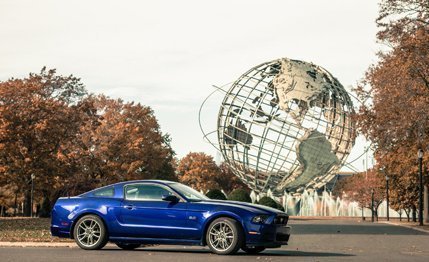
Fresh rubber raised the Stang’s skidpad grip from 0.89 g to 0.94 and reduced the 70-to-zero braking distance by a yard, to 166 feet. Acceleration was nearly identical to the initial testing. The quarter-mile time grew 0.1 second and the trap speed fell 2 mph, to 109, indicating that the engine might have lost a pony or two over 40,000 miles.
We averaged 19 miles per gallon, which happens to be the EPA’s combined fuel-economy estimate. We accumulated the majority of those miles on daily commutes. Editors stayed away from long trips because of the limited highway range of about 300 miles from 16 gallons of fuel, though the car did travel to Florida, New York, and Minnesota, and to North Carolina where Morse Measurements did its reverse engineering [see sidebar]. While the fuel-filler flap is mute on the subject, the Mustang’s owner’s manual calls for premium fuel to achieve maximum power and performance. Pumping premium throughout this test added more than $500 to the Mustang’s operating cost.
A few warranty claims notwithstanding, the GT felt as strong and looked as good when it left us as it did when it arrived. Let’s hope the solid axle wasn’t the thing keeping the Mustang franchise alive for 50 years, because the sixth-gen car ditches it for an independent rear suspension. Say, Ford—can we try one of those for 40,000 miles, too?
MIKE SUTTON: The center console and cup holders are a mess of hard plastic and sharp angles.
TONY SWAN: The baritone rumble of the 5.0 V-8 is intoxicating. I can't imagine ever growing weary of the omnipresent reminder of all that thrust on tap.
KEVIN A. WILSON: If I am to have any hope of driving this car smoothly at anything short of go-like-hell, I need more time in the gym doing leg presses.
JENNIFER HARRINGTON: Surprisingly comfortable ride for a six-hour trip, even with the GT suspension.
RON SESSIONS: The 5.0 is one of the best 1965 Mustangs I've ever driven. Modern shock tuning has done wonders with the ox-cart rear axle.
AARON ROBINSON: Mustang as a daily driver, who would'a thought? A great advertisement for why you don't need MyFord Touch.
DANIEL PUND: As the former owner of the all-time worst Mustang in the history of the breed, a Ghia-edition Mustang II, I can tell you this is better. It needs a landau top, though.
AUSTIN LINDBERG: I feel this package lacks. Maybe that's where the Boss comes in, but I had more fun in the V-6.
ERIC TINGWALL: You can't argue with irrational amounts of power for reasonable money, but the awkward driving position is a deal-breaker for me.
ANGELA KUJAVA: This car turns my husband [K.C.] into a jackass.